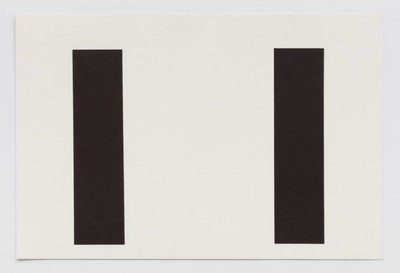John McLaughlin: Linocuts
Van Doren Waxter, New York
Through May 1, 2021
Linocut - Title # 8, c. 1973
Only state, Linocut, 12 x 18 inches (30.5 x 45.7 cm)
© Estate of John McLaughlin, Courtesy Van Doren Waxter
Linocut - Title # 3, c. 1973
Only state, Linocut, 12 x 18 inches (30.5 x 45.7 cm)
© Estate of John McLaughlin, Courtesy Van Doren Waxter
Van Doren Waxter presents John McLaughlin: Linocuts, a special presentation of rare, intimately scaled geometric prints by the late modernist. A seminal figure in West Coast Abstraction, JOHN McLAUGHLIN (1898-1976) was a midcentury innovator of perception whose hard, clean edged paintings anticipated California art movements of the 1960s and 1970s, including West Coast Minimalism and Light and Space.
A disciplined, self-taught artist admired among postwar Abstractionists and Minimalists for his precision and clarity of vision, John McLaughlin’s oeuvre is characterized by elegant, rectangular forms. His work evolved from an interest in Sesshu Toyo, a 15th Century Japanese artist and Zen monk, whose approach to ink painting introduced the concept of “emptiness” or the “marvelous void” into Japanese painting. “In McLaughlin’s work,” art critic and curator Michael Duncan wrote on the occasion of an acclaimed retrospective at the Los Angeles County Museum of Art (2016), “the placement of two black forms on a white field becomes a metaphysical event.”
The eight linocuts were planned in the artist’s studio in Dana Point, Laguna Beach in his late 70s, a year prior to a solo show at The Whitney Museum of American Art (1974). These never before shown or reproduced richly textured works on paper are the result of a long-distance project conducted via postal mail. The works were printed and cut at the French atelier of the legendary printer Hildago Arnéra, known for collaborating with Pablo Picasso. Each of the poignant works evince the artist’s interests in contemplation, silence, and nature.
An untitled linocut (all c. 1973), pictured, features a layering of two black vertical rectangular bars atop a bright expanse; while in another, also pictured, two black bands hover horizontally over a white form. In each, all measuring uniformly 18.1 x 11.9 inches, serene and solemn bars, blocks, and volumes bisect open, large fields, suggesting serenity and the natural world. The American art critic Phyllis Tuchman recently asserted that a green field in John McLaughlin’s paper constructions, also made in 1973, suggests “that such black and white forms exist in a landscape…the rest of the sheets literally traverse states of light and dark.” Likewise, the linocuts invoke the sensuous and the divine, a presence and a void.
JOHN McLAUGHLIN was an American abstract painter born in Sharon, MA in 1898 and died in Dana Point, CA in 1976. In 1935, John McLaughlin and his wife Florence Emerson (descendant of Ralph Waldo Emerson) moved to Japan where they lived for three years. Upon their return in 1938, John McLaughlin established a business dealing Japanese prints. It was around this time that he decided to start painting, which was brought to a halt just a few years later with the start of the War. Fluent in Japanese, John McLaughlin was recruited as a translator by the Army during WWII. After the war, McLaughlin settled in Dana Point, California, where he started painting full time in 1946. Entirely self-taught, the artist continued to paint, with considerable success in his later career, until his death in 1976. He was the subject of a major retrospective at the Los Angeles County Museum of Art (2016-2017).
VAN DOREN WAXTER
23 East 73rd Street, New York, NY 10021


